Топик: The Queen of the UK
The Queen was born in London on 21 April 1926, the first child of The Duke and Duchess of York, subsequently King George VI and Queen Elizabeth. Five weeks later she was christened Elizabeth Alexandra Mary in the chapel at Buckingham Palace.
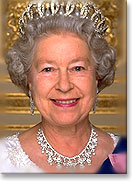
The Princess's early years were spent at 145 Piccadilly, the London house taken by her parents shortly after her birth; at White Lodge in Richmond Park; and at the country homes of her grandparents, King George V and Queen Mary, and the Earl and Countess of Strathmore. When she was six years old, her parents took over Royal Lodge in Windsor Great Park as their own country home.
EDUCATION
Princess Elizabeth was educated at home with Princess Margaret, her younger
sister. After her father succeeded to the throne in 1936 and she became heir
presumptive, she started to study constitutional history and law. She also
studied art and music; learned to ride (she has been a keen horsewoman since
early childhood); and enjoyed amateur theatricals and swimming - she won the Children's
Challenge Shield at London's Bath Club when she was thirteen. She enrolled as a
Girl Guide when she was eleven, and later became a Sea Ranger.
EARLY PUBLIC LIFE
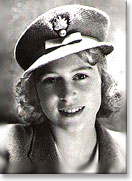 As the Princess grew older she began to
take part in public life. She broadcast for the first time in October 1940,
when she was 14; she sent a message during the BBC's children's programme to
all the children of Britain and the Commonwealth, particularly to those
children who were being evacuated for safety reasons. In early1942 she was appointed
Colonel-in-Chief of the Grenadier Guards, and on her sixteenth birthday she
carried out her first public engagement, when she inspected the regiment. In
April 1943, Princess Elizabeth carried out her first solo public engagement,
when she spent a day with a Grenadier Guards tank battalion in Southern
Command.
As the Princess grew older she began to
take part in public life. She broadcast for the first time in October 1940,
when she was 14; she sent a message during the BBC's children's programme to
all the children of Britain and the Commonwealth, particularly to those
children who were being evacuated for safety reasons. In early1942 she was appointed
Colonel-in-Chief of the Grenadier Guards, and on her sixteenth birthday she
carried out her first public engagement, when she inspected the regiment. In
April 1943, Princess Elizabeth carried out her first solo public engagement,
when she spent a day with a Grenadier Guards tank battalion in Southern
Command.
Thereafter
her official duties increased, particularly in connection with young people:
she was President of the Queen Elizabeth Hospital for Children in Hackney and
the National Society for the Prevention of Cruelty to Children. From March 1944
onwards, she also began to accompany the King and Queen on many of their tours
within Britain.
Shortly after her eighteenth birthday in 1944, Princess Elizabeth was appointed
a Counsellor of State during the King's absence on a tour of the Italian
battlefields and, for the first time, carried out some of the duties of Head of
State. In August that year, with Queen Elizabeth, the Princess received an
address from the House of Commons, and replied on behalf of the Throne.
In September 1944, the Princess carried out her first official tour of Scotland
with her parents, including her first opening ceremony in October when she
opened the recently reconstructed Aberdeen Sailors' Home. The Princess's first
flight by air was in July 1945, when she accompanied the King and Queen on a
two-day visit to Northern Ireland.
In early 1945 the Princess was made a Subaltern in the Auxiliary Territorial Service (ATS). By the end of the war she had reached the rank of Junior Commander, having completed her course at No. 1 Mechanical training Centre of ATS and passed out as a fully qualified driver.
After the end of the war, Princess Elizabeth's public engagements continued to grow, and she travelled extensively to attend public functions throughout the British Isles. These included the launching of a new aircraft carrier in Belfast and a tour of Ulster in March 1946, and attending the National Eisteddfod of Wales in August 1946.
Her first official overseas visit took place in 1947, when she accompanied her parents and sister on a tour of South Africa. During this tour she celebrated her twenty-first birthday, and gave a broadcast address dedicating herself to the service of the Commonwealth - a dedication she repeated five years later on her accession to the throne.
On her return from the South Africa tour, Princess Elizabeth received the freedom of the City of London in June 1947; in July, she received the freedom of the city of Edinburgh.
In November 1947, Princess Elizabeth was created a Lady of the Garter at a private investiture by the King.
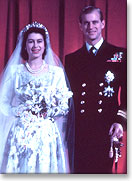
MARRIAGE
AND FAMILY
Shortly after the Royal Family returned from South Africa, the Princess's
engagement to Lieutenant Philip Mountbatten was announced. The couple, who had
known each other for many years, were married in Westminster Abbey on 20
November 1947. Lieutenant Mountbatten, now His Royal Highness The Prince
Philip, Duke of Edinburgh, was the son of Prince Andrew of Greece and a
great-great-grandson of Queen Victoria.
The
Royal couple had four children, and seven grandchildren.
Prince Charles, now The Prince of Wales, Heir apparent to the throne, was born
in 1948, and his sister, Princess Anne, now The Princess Royal, two years
later.
After Princess Elizabeth became Queen, their third child, Prince Andrew,
arrived in 1960 and the fourth, Prince Edward, in 1964. Prince Andrew and
Prince Edward were the first children to be born to a reigning monarch since
Queen Victoria had her family.
Their grandchildren are Peter and Zara Phillips (b. 1977 and 1981); Prince William of Wales and Prince Henry of Wales (b. 1982 and 1984); Princess Beatrice of York and Princess Eugenie of York (b. 1988 and 1990); and The Lady Louise Windsor, daughter of The Earl and Countess of Wessex (b. 2003).
ACCESSION AND CORONATION
After her marriage Princess Elizabeth paid formal visits with The Duke of
Edinburgh to France and Greece; in autumn 1951 they toured Canada. She also
visited Malta four times while The Duke was stationed there on naval duties. In
1952, King George VI's illness forced him to abandon his proposed visit to
Australia and New Zealand. The Princess, accompanied by Prince Philip, took his
place. On 6 February, during the first stage of this journey, in Kenya, she
received the news of her father's death and her own accession to the throne.
Her Majesty's coronation took place in Westminster Abbey on 2 June 1953. Representatives of the peers, the Commons and all the great public interests in Britain, the Prime Ministers and leading citizens of the other Commonwealth countries, and representatives of foreign states were present. The ceremony was broadcast on radio around the world and, at The Queen's request, on television. It was television, then in its relative infancy, that brought home the splendour and the deep significance of the coronation to many hundreds of thousands of people in a way never before possible. The coronation was followed by drives through every part of London, a review of the fleet at Spithead, and visits to Scotland, Northern Ireland and Wales.
ROLE AS MONARCH
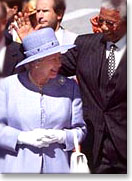
In winter 1953 Her Majesty set out to accomplish, as Queen, the Commonwealth
tour she had begun before the death of her father. With The Duke of Edinburgh
she visited Bermuda, Jamaica, Fiji, Tonga, New Zealand, Australia, Ceylon,
Uganda, Malta and Gibraltar. This was the first of innumerable tours of the
Commonwealth they have undertaken at the invitation of the host governments.
During the past fifty years The Queen and Prince Philip have also made frequent
visits to other countries outside the Commonwealth at the invitation of foreign
Heads of State.
Since her Coronation, The Queen has also visited nearly every county in Britain, seeing new developments and achievements in industry, agriculture, education, the arts, medicine and sport and many other aspects of national life.
As Head of State, The Queen maintains close contact with the Prime Minister, with whom she has a weekly audience when she is in London, and with other Ministers of the Crown. She sees all Cabinet papers and the records of Cabinet and Cabinet Committee meetings. She receives important Foreign Office telegrams and a daily summary of events in Parliament.
Her Majesty acts as host to the Heads of State of Commonwealth and other countries when they visit Britain, and receives other notable visitors from overseas.
She holds Investitures in Britain and during her visits to other Commonwealth countries, at which she presents honours to people who have distinguished themselves in public life.
As Sovereign, Her Majesty is head of the Navy, Army and Air Force of Britain. On becoming Queen she succeeded her father as Colonel-in-Chief of all the Guards Regiments and the Corps of Royal Engineers and as Captain-General of the Royal Regiment of Artillery and the Honourable Artillery Company. At her Coronation she assumed similar positions with a number of other units in Britain and elsewhere in the Commonwealth. (A full list appears in Whitaker's Almanack.)
Every year, Her Majesty entertains some 48,000 people from all sections of the community (including visitors from overseas) at Royal Garden Parties and other occasions. At least three garden parties take place at Buckingham Palace and a fourth at the Palace of Holyroodhouse, in Edinburgh. Additional 'special' parties are occasionally arranged, for example to mark a significant anniversary for a charity. In 1997, there was a special Royal Garden Party attended by those sharing The Queen and The Duke of Edinburgh's golden wedding anniversary. In the summer of 2002 there was a special Golden Jubilee Garden Party for individuals born on Accession Day, 6 February 1952.
Her Majesty also gives regular receptions and lunches for people who have made a contribution in different areas of national and international life. She also appears on many public occasions such as the services of the Orders of the Garter and the Thistle; Trooping the Colour; the Remembrance Day ceremony; and national services at St Paul's Cathedral and Westminster Abbey.
The Queen is Patron or President of over 700 organisations. Each year, she undertakes a large number of engagements: some 478 in the UK and overseas in 2003.
ANNIVERSARIES
In 1977 The Queen's Silver Jubilee was celebrated in Britain and throughout the
Commonwealth. Accompanied by The Duke of Edinburgh, The Queen travelled some
90,000 kilometres (56,000 miles) to share the anniversary with her people.
Enormous crowds greeted them wherever they went, and millions more shared in
the celebrations through radio and television. In 1986 The Queen took part in
celebrations in Windsor and London to mark her sixtieth birthday.
Although
it was not regarded as a Jubilee, the 40th anniversary of The Queen's Accession
in 1992 was marked by a number of events and community projects in the UK.
These were organised privately or through the Royal Anniversary Trust. On
Accession Day itself, 6 February, the BBC broadcast Elizabeth R, a television
documentary on The Queen's working life. This was subsequently shown in over 25
countries around the world.
On 20 November 1997 The Queen and The Duke of Edinburgh celebrated their Golden
Wedding. A special Garden Party for couples celebrating their Golden Wedding
was held at Buckingham Palace in July. The anniversary itself was marked by a
service at Westminster Abbey, a lunch hosted by the Government at Banqueting
House and a family dance held in the newly restored State Rooms at Windsor
Castle.
The
year 2002 saw The Queen's Golden Jubilee, marking 50 years since The Queen's
Accession (rather than the Coronation, which took place in 1953). This special
milestone had previously been achieved by only five earlier British monarchs -
King Henry III, King Edward III, King James VI and I, King George III and Queen
Victoria.
Celebrations in the United Kingdom ran throughout the summer months of 2002,
including extensive regional visits. The Jubilee Weekend saw the focus of national
celebrations, including two free public concerts for over 24,000 people in
the gardens of Buckingham Palace, a pageant in the Mall, a service of
thanksgiving at St. Paul's Cathedral, and an appearance on the balcony of
Buckingham Palace before a crowd of one million people. During the course of
the year The Queen and The Duke of Edinburgh also visited Australia, New
Zealand, Jamaica and Canada.
HORSEMANSHIP
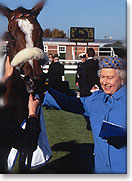 Her Majesty takes a keen and highly
knowledgeable interest in horses. She attends the Derby at Epsom, one of the
classic flat races in Britain, and the Summer Race Meeting at Ascot, which has
been a Royal occasion since 1911. As an owner and breeder of thoroughbreds, she
often visits other race meetings to watch her horses run, and also frequently
attends equestrian events. In 1984, 1986 and 1991 Her Majesty made brief private
visits to the United States to see stallion stations and stud farms in
Kentucky.
Her Majesty takes a keen and highly
knowledgeable interest in horses. She attends the Derby at Epsom, one of the
classic flat races in Britain, and the Summer Race Meeting at Ascot, which has
been a Royal occasion since 1911. As an owner and breeder of thoroughbreds, she
often visits other race meetings to watch her horses run, and also frequently
attends equestrian events. In 1984, 1986 and 1991 Her Majesty made brief private
visits to the United States to see stallion stations and stud farms in
Kentucky.